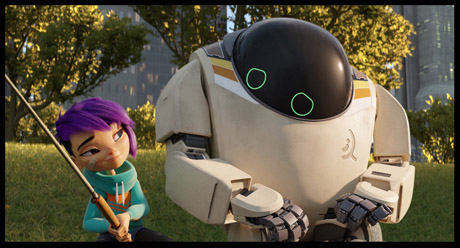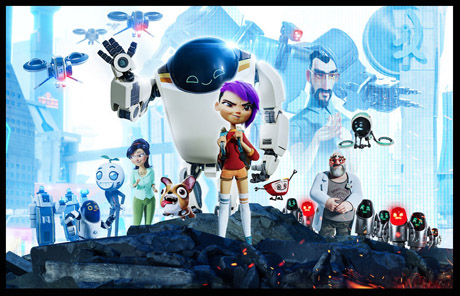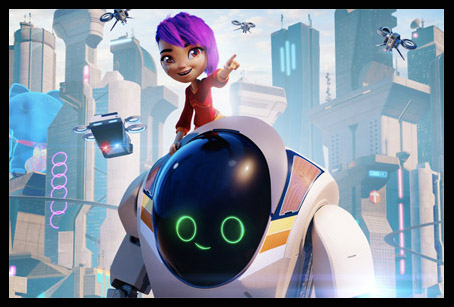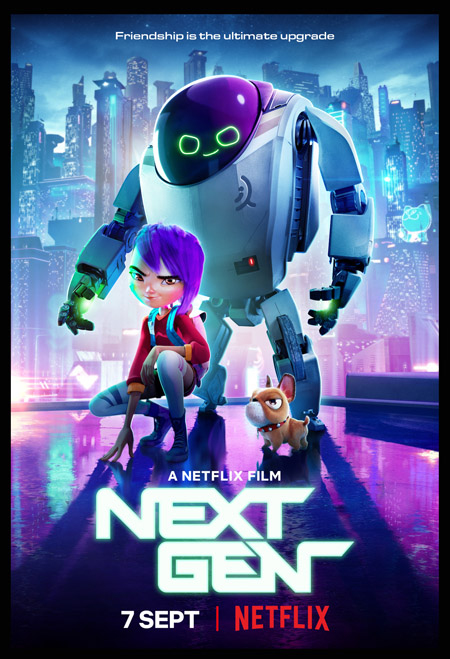
“Next Gen” is an unconventional animated movie in content, execution and delivery. This sci-fi cautionary tale, about a lonely girl and her relationship with a thoughtful combat robot, takes its look from some of the great visual films of our time. The story balances action, drama, comedy and suspense with both adult and adolescent themes. Directors Kevin Adams and Joe Ksander were in charge of putting it all together.
Jackson Murphy: For both of you, this is your feature film directorial debut. So after years of working in the animation and the visual effects department on so many movies, how did it feel to finally be in total control of a feature?
Kevin Adams: Well, my plan for world domination – this has been a great step towards that. (laughs) No, it’s good. One of the things you do as you go along working in the industry – the reason you start to write and start to want to direct is because you start to get this feeling like, “Damn, I think I could actually do this and possibly better.” It’s a little bit of arrogance, obviously, but you kind of want to prove it. So this film was a tremendous opportunity for us to say Okay. We have to put our money on the line and actually see if we can do what we think we can do. It’s been a great learning experience, but also edifying to realize that some of the things we suspected actually kind of work.

Joe Ksander: Yeah, Kevin’s right. And we actually got really lucky on this as a first feature. A lot of that can be owed to our producing partner, Olivia Hao and her team at Baozou because they gave us a tremendous amount of creative freedom to accomplish this. A first feature is a tough thing to do at the best of times, but she definitely gave us the window to say what we wanted to say – do what we wanted to do. We worked with them… and as an opportunity, it was hard to pass up.
JM: And one of the big headlines to come out of this movie is that Netflix bought it at the Cannes Film Festival in May for $30 million. That must’ve been a great relief for you guys to have a home for this movie. And how many of those millions did you guys get to split?
JK: I’ll tell you once I get the check.
KA: I suspect it’s close to none, but we were compensated fine. The real thing here is that we got a chance to make these things, which is what we’re in it for anyway.
JK: And it was great for the producers because they paid back their investors, and that takes a big weight off of them. And that’s a lot of money. It’s not a lot of money for an animated feature, frankly, but it’s a lot of money for a first feature. The environment that Netflix created since the purchase happened has been really great and really collaborative. We got kind of lucky on this thing and we were always gonna do what we want. We were gonna make the movie we want, but kept waiting for the other shoe to drop. When Netflix purchased the film, we were thinking “Okay. Here it comes – all the crazy studio notes.” But they’ve been nothing but supportive. They really see the same film – to make the same film we’re trying to make. They see it in the same way, and they’re really supportive of what we’re trying to do.
JM: That’s great to hear.

KA: The film is slightly challenging in that it’s not exactly what a lot of North American people think of when they think of animation. We sort of expected that if we were going to get distribution, there was going to be a lot of changes that needed to happen to it. But the fact that Netflix bought it and were so gracious about saying, “Well, this is the film you made and this is the film we bought.” that even when they had notes, they were making the same film we were and let us try something new. So it is an awesome home for letting people try new things in animation, which the market would not necessarily allow before they got on the scene.
JM: And this is an unconventional film – for animation and movies in general. But it works in a lot of ways. And it is based on this comic, “7723”. Joe, what was your introduction to the “7723” comic?
JK: Well, truth be told, I didn’t actually see the comic originally. I don’t know that Kevin did either. We were brought on originally as writers on this before we were asked to direct. And there was already a version of the film that was sort of in production – an early pre-production. And that’s where we started from. We came on as writers to help that version of it. But then, as we worked with Olivia and her team, she kind of realized that we liked a lot of the same things. So she asked us “If you have no restrictions – if you could write your own version – what would that be?” And we started, sort of, from page one.
That being said, the original idea – the idea of this reboot who has to delete memories every night – who has to choose which memories to hold onto – that’s a great, core idea. And that’s the thing that started the comic and held through in all versions of this movie. In fact, our main human character, Mai Su, we designed to be the perfect… antagonist to this robot – the robot who doesn’t want to lose any memories of the girl who has memories she wants to lose. We designed them to work together. But it all came from that core idea that was in the comic.
JM: And I think this plotline is relatable to a lot of people, because when you look at your phone, it tells you to keep deleting things in order to make room for more space. Doesn’t that just get annoying?
KA: (laughs) Yeah, mildly. What is that thing – that iCloud thing that keeps coming back?
JM: Yeah.

KA: I have to keep increasing the size of my iCloud because I can’t be bothered to go and sort through my pictures and delete them like I should.
JM: I hate when I keep having to do that on my phone. Visually, there are a lot of things that reminded me of “Blade Runner” and “Blade Runner 2049”. Were those movies inspirations for “Next Gen”?
KA: Absolutely. [“Blade Runner”] is one of Joe and my top favorite films of all-time. In fact, the style that we sort of came around to on the film – we sort of tagged it as “Happy Blade Runner”. Originally, we got a production designer on it before anybody else: a friend of mine, Craig Sellars. He’s been doing work for “Guardians of the Galaxy” and Marvel movies. And we hired him specifically because he doesn’t do animation, and our points of reference were – we’re taking reference from 70s Neo-Noir, “Dog Day Afternoon” and Film Noir, which are the same places they’re taking reference from when they made “Blade Runner”. And then on top of that, we just liked a lot of the formulative stuff that they were crafting in the “Blade Runner” world, so we took some of that on board.
But of course we replaced some of the Japanese content with Chinese. And then we’re heavily influenced by a lot of 70s stuff – not bellbottoms and afros, but Brutalist architecture and the Futurism design. Even our robots are based on an old Atari and another computer.
JK: Commodore 64.
KA: Exactly!
JM: I like “Blade Runner” and love “2049” – visual stunning. And you get visuals like that here. And I think there’s a bit of a Steve Jobs/Steve Wozniak vibe going on in this movie as well.
JK: You’re talking about Justin Pin and Dr. Tanner Rice, who are the scientists and industrialists who create all the robots in the world, known as Q-Bots. We’re not making a particular critique of Apple. We’re huge fans of Apple, like a lot of people are. But there’s a really good story about how Apple came to be. The original Macintosh interface was based on something Steve Jobs saw: a Defense Department contract over a xeroxed part. I always love the idea that this revolution in the way we interact with computers came from what is essentially a program designed to fight the Russians. There’s a certain interesting darkness to the backstory of that.
And so we took some inspiration from that: there’s a happy consumer product world out there, but the roots of that are deeper and darker. And that’s Justin Pin and Tanner Rice. And they have a story – and a backstory. And there’s hints of that backstory, if you go back and look at, you can see evidence of their history together.
JM: And I would say there’s a bit of darkness to the dog in the movie as well because Michael Pena voices Momo. He has a very R-rated vocabulary.
JK: 100% PG. I’ll put that out right there. (laughs)
KA: If you Michael Pena in a booth for two days and you ask him to swear – give him some rough outlines and just let him go – and you realize that guy is like a Profanity Master. It’s like an art form for him. He goes on constantly and never repeats himself. We’re all just in a bit in awe of it all. At the end of the day, we only did two sessions with him because there was so much material to cut from. We could probably build another two or three movies off of the stuff he gave us.

JM: The cast is tremendous. Besides Pena, there’s John Krasinski, David Cross, Jason Sudeikis and Constance Wu from “Crazy Rich Asians”. What was it like working with her?
JK: Constance is a pro. She’s friendly. She’s funny, and she’s sharp. And she’s a comedian. One of the great things about this film is that we got to work with a bunch of comedians. Even when we were doing dramatic stuff, people with that comic timing can be really good. There’s a bit at the end of the movie where Constance’s character, Molly Su, has to come out with a confession of her love for her daughter that gets all the angst and trouble she’s been through – gets it all out in one fell swoop. And it’s a really big speech done really fast.
In fact, when we had done the temp dialogue – the scratch track – we had scratched in the dialogue and hadn’t sped it up to make it feel a little bit faster and funnier. But Constance was like, “Here – let me try it.” And she hit it at a million miles an hour, and it’s the funniest thing in the movie.
JM: It’s a nice moment. And you notice a lot of other small details over the course of the movie, especially when it comes to advertising – from food to electric toothbrushes.
KA: You can’t really ask that question without touching on the robotization of the world. So there’s this thing that happened – I guess in the 80s – where all the consumer products were, “It’s electric. It’s amazing. I know you can carve your turkey, but check this knife out. It’s an electric knife.” There was a big movement and everything was like that. We play a little bit on that, and it also ties into the whole technological revolution of phones that’s happening right now.
JM: And which tech device has taken over your lives?
JK: It’s the electric toothbrush, for sure. (laughs)
KA: That was gonna be my answer. But it has to be my cell phone – something that you look at just before you go to bed and you wake up to and check first thing in the morning. I would like to see what my life would be like without it.
“Next Gen” is now streaming on Netflix.
- INTERVIEW: “Inside Out 2” Director And Producer On Pixar Sequel - April 16, 2024
- INTERVIEW: “Puffin Rock And The New Friends” And 25 Years Of Cartoon Saloon - April 10, 2024
- INTERVIEW: “Chicken For Linda!” Directors On Annecy Winning Feature - April 9, 2024


 September 14th, 2018
September 14th, 2018  Jackson Murphy
Jackson Murphy  Posted in
Posted in  Tags:
Tags: 






